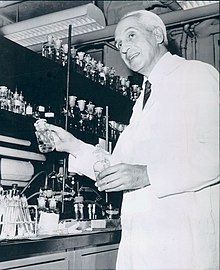Severo Ochoa
| Severo Ochoa | |
|---|---|

Severo Ochoa in 1959
|
|
| Born |
September 24, 1905 Luarca, Asturias, Spain |
| Died | November 1, 1993 (aged 88) Madrid, Spain |
| Residence | Spain, United Kingdom, Germany, United States |
| Citizenship |
Spanish (1905–93) American (1956–93) |
| Fields | Biochemistry, molecular biology |
| Institutions |
NYU's School of Medicine Roche Institute of Molecular Biology (Nutley) |
| Known for | Discovery of mechanisms in the biological synthesis of RNA and DNA. |
| Influenced | Arthur Kornberg |
| Notable awards |
Nobel Prize (1959) Paul Karrer Gold Medal (1963) National Medal of Science (1979) |
Severo Ochoa de Albornoz (Spanish: [seˈβeɾo oˈtʃoa ðe alβorˈnoθ]; 24 September 1905 – 1 November 1993) was a Spanish physician and biochemist, and joint winner of the 1959 Nobel Prize in Physiology or Medicine with Arthur Kornberg.
Severo Ochoa was born in Luarca (Asturias), Spain. His father was Severo Manuel Ochoa, a lawyer and businessman, and his mother was Carmen de Albornoz. Ochoa was the nephew of Álvaro de Albornoz (President of the Second Spanish Republic that was exiled, 1947–1951), and a cousin of the poet and literary poet and critic Aurora de Albornoz. His father died when Ochoa was seven, and he and his mother moved to Málaga, where he attended elementary school through high school. His interest in biology was stimulated by the publications of the Spanish neurologist and Nobel laureate Santiago Ramón y Cajal. In 1923, he went to the University of Madrid Medical School, where he hoped to work with Cajal, but Cajal retired. He studied with father Pedro Arrupe, and Juan Negrín was his teacher.
Negrín encouraged Ochoa and another student, José Valdecasas, to isolate creatinine from urine. The two students succeeded and also developed a method to measure small levels of muscle creatinine. Ochoa spent the summer of 1927 in Glasgow working with D. Noel Paton on creatine metabolism improving his English skills. During the summer he refined the assay procedure further and upon returning to Spain he and Valdecasas submitted a paper describing the work to the Journal of Biological Chemistry, where it was rapidly accepted [Ochoa, S., and Valdecasas, J. G. (1929) A micromethod for the estimation of total creatinine in muscle. J. Biol. Chem. 81: 351–357], marking the beginning of Ochoa's biochemistry career.
...
Wikipedia
